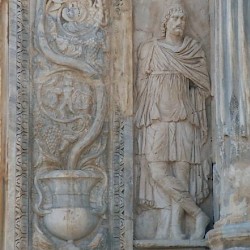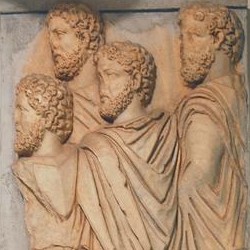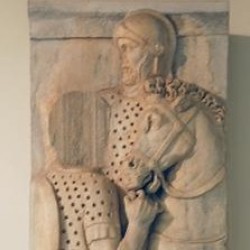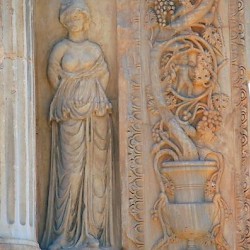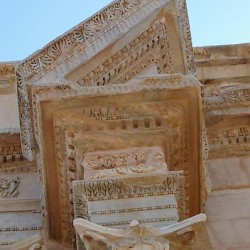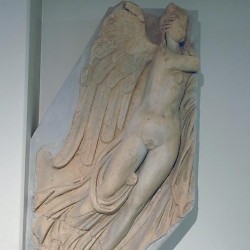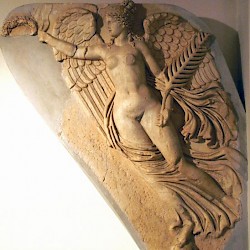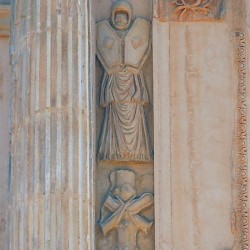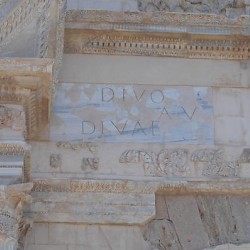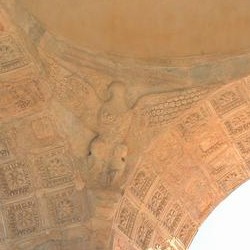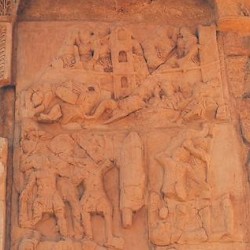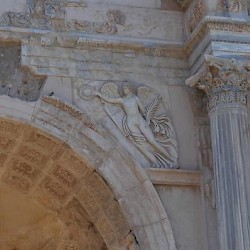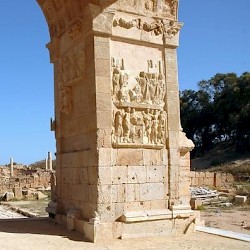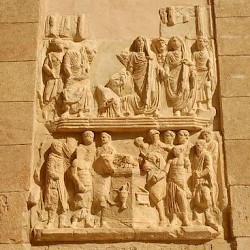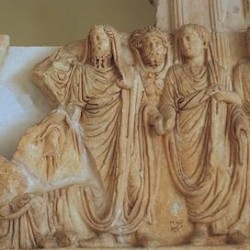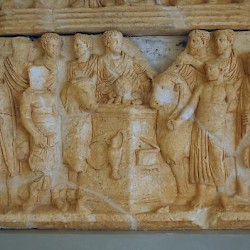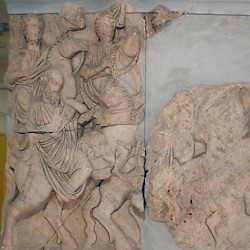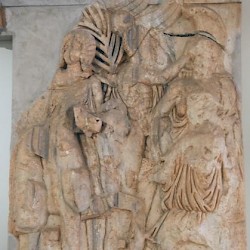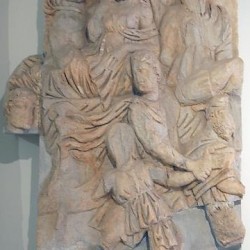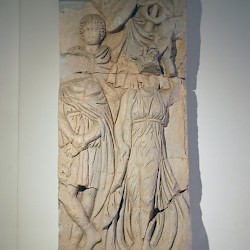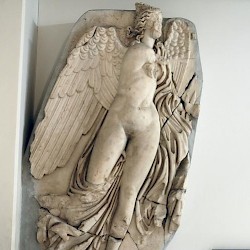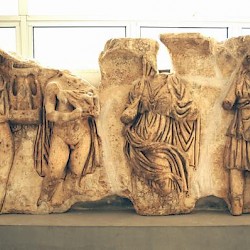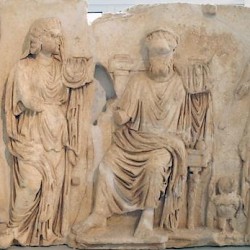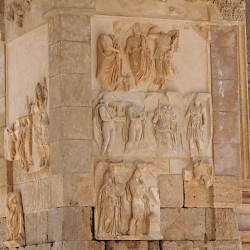Lepcis Magna, Arch of Septimius Severus
Q3621792Lepcis Magna: Phoenician colony, later part of the Carthaginian empire, the kingdom of Massinissa, and the Roman empire. Its most famous son was the emperor Septimius Severus (r.193-211).
Arch of Septimius Severus
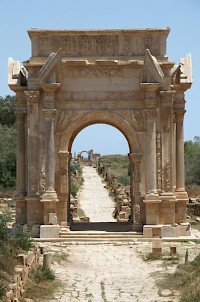
This is the Arch of Septimius Severus, seen here from the southwest, as one would have seen it when one approached the city of Lepcis Magna from the countryside. You are looking along the Cardo to the northeast; the arch in the distance was dedicated to the emperor Trajan. Severus' arch was erected for Lepcis' most famous son, the man who was emperor of the Roman Empire from 193 to 211.
Southwest: Concordia
The monument cannot be dated precisely, but it is likely that the citizens of Lepcis Magna started the construction as soon as possible: immediately after their fellow citizen had become emperor and had stabilized the Empire after the wars of the Year of the Five Emperors (193). This is confirmed by the fact that the defeated enemies, so common on an honorific arch, are Parthians, who had been defeated twice by Severus at the beginning of his reign.
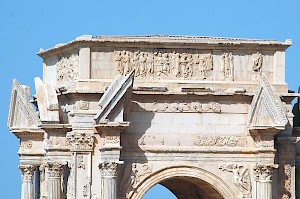
Had the arch been erected later, we would have seen African Garamantes, who were pacified in 201/202 and against whom the Limes Tripolitanus was built. (The forts at Bu Njem, Gheriat el-Garbia, and Ghadames were built at this time.) This photo shows the southwest face ("frieze D"), which represents a familiar theme from the imperial propaganda: Concordia.
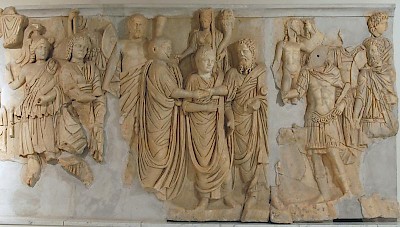
The central scene shows the friendship (concordia) within the imperial family: the emperor is shown shaking hands with his sons, Caracalla and Geta (the head is a replica; the original was stolen by an allied soldier during the Second World War). To the left we can see the empress, Julia Domna, and to the far left is the goddess Roma. The two men to the right are the praetorian prefect, Plautianus (headless, in a military costume), and the emperor's brother Publius Septimius Geta.
Caracalla is shown as a tall young man, not quite grown-up, and this offers a clue for the moment of completion of the arch: in the early 200s, when he was about sixteen or seventeen years old. This coincides with the emperor's visit to Lepcis Magna in 202-203, when he rebuilt many monuments in his hometown, like the Severan Forum, the Severan Basilica, the Temple of the Septimians, and the Port.
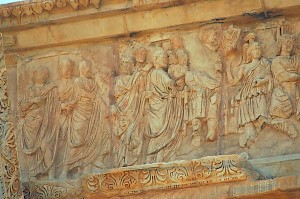
If we assume that constructing the arch lasted from 194 to 202, we cannot be very far from the truth. Eight years, however, is a long time, especially when we take into account that the core of the four piers was already there. This can be deduced from the fact that it is made of local limestone, found at Ras el-Hamman. The quarries, however, were closed by the age of Septimius Severus, and we must therefore assume that the inner structure is older, and was merely redecorated. This is confirmed by the fact that the limestone was measured in Punic cubits, which had been replaced by Roman feet before the age of Severus. Perhaps, the work was interrupted, and hurriedly completed when the emperor announced his visit.
This may also explain the different quality of artwork. Several reliefs are beautifully carved, like the barbarians on the pictures below and the broken pediment (more below), while other parts of the decoration look like routine work by artists who were certainly talented but no geniuses. However, many details will for some time remain unclear, because the arch as we see it today is essentially a reconstruction. The foundations and part of the structure were excavated in the 1920s, but many parts the decoration were found elsewhere in the city. It is likely that the missing parts are still buried somewhere. So, for the time being, our understanding of this monument is incomplete and the exact chronology of its construction remains unclear.
The overall design is daringly baroque, although it is not completely novel. In the first place, it faces four directions (quadrifrons), and not two. This is not unique but rare, although a similar arch, dedicated to Lucius Verus and Marcus Aurelius, can be found in the nearby city of Oea (modern Tripoli). There is also a parallel in Rome: the Arch of Janus Quadrifrons, which is about a century younger than the arch in Lepcis.
As always, we can see captive barbarians (dressed like Parthians) on the pedestals, trophies on the pier itself and Victories in the spandrels. However, the broken pediment in the upper part is very unusual, and so is the extensive (but poorly preserved) decoration underneath the groin vault, which matches the frieze in the attic.
Another aspect of the decoration is the use vines and grapes. The latter is an extremely common motif in Lepcis Magna, because one of the city's two protective deities was Shadrapa, a Phoenician healing god who was usually associated with Dionysus or Liber Pater, gods associated with the cult of wine. The other protective god was Milkashtart, a hypostasis of the macho god Melqart associated with the goddess of love, Astarte. The Greeks and Romans believed that Melqart was identical to Hercules, and he figures on the arch of Septimius Severus as well.
Above the female captive, one can discern this trophy, the ancient Greek system for victory. We can see a helmet, two shields, two tunics, and greaves. The hexagonal shields are not Parthian; they were popular among the tribal warriors from Germania. As we have already seen, there is a striking disparity in quality, and the core of the four piers is older than the decoration. It is possible, but far-fetched, that the arch was originally designed to celebrate the Parthian victory of Lucius Verus (r.161-169) and the Germanic wars of his co-ruler Marcus Aurelius (r.161-180).
In the spandrels, we can see the winged Victories that are part of almost any Roman triumphal arch (an exception is the arch of Marcus Aurelius and Lucius Verus in Tripoli, which is decorated with griffins). The Victories carry laurel wreaths and palm branches. The combination of conventional themes and unusual, almost rococo elements like the broken pediment suggest that the designer was born somewhere in the eastern provinces of the empire, where this type of decoration was less uncommon than in Italy.
Northwest: Virtus
Like the arch at Oea, the corners of the monument at Lepcis Magna were directed to the four corners of the compass. The groin vault to which the four gates gave access, covered the crossroads of the main streets of the city, the Cardo (which leads from the center out of town) and the ecumanus, the road along the coast that started in Alexandria in Egypt and continued to Carthage and beyond. In other words, this was the point where all roads from Lepcis Magna began, and distances were measured from the arch. Indeed, there is a milestone at a stone's throw from the arch.
The northwest face of the arch was directed to Oea (modern Tripoli), the great rival city of Lepcis. The theme of this part of the monument is military virtus: the makers wanted to stress Septimius Severus' qualities as a general. And indeed, he was a great conqueror, who had added Mesopotamia to the Empire.
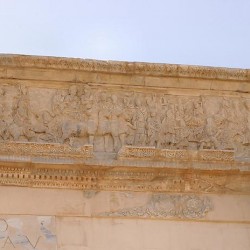 Lepcis, Arch of Septimius Severus, NW, frieze (copy) |
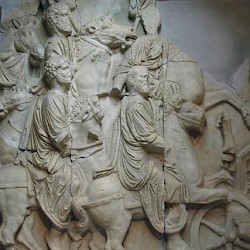 Lepcis, Arch of Septimius Severus, NW, frieze |
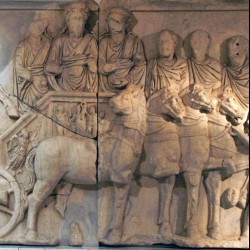 Arch of Septimius Severus, NW frieze, central scene |
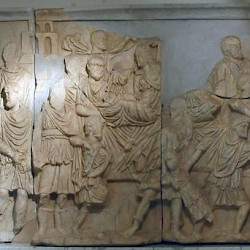 Lepcis, Arch of Septimius Severus, NW, frieze |
Several large fragments have survived of what is called "frieze A". Above, we see a group of mounted men, dressed in the toga. They must be important people, perhaps senators or knights, or the elite of Lepcis Magna. Alternatively, they are soldiers in civil dress - after all, the two men in the background carry military standards. This is high quality work.
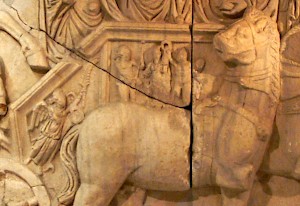
The central scene of this frieze, the third photo above, shows the emperor and his two sons Caracalla and Geta in his triumphal chariot, entering his hometown. On the chariot itself you can see a Victory and Tyche (Fortune) crowning the two protective gods of Lepcis Magna, Liber Pater and Hercules. Among the faceless people in the background, we can perhaps discern the emperor's right-hand man Plautianus and the emperor's brother Publius Septimius Geta. The young man cannot be identified. Elsewhere on the relief, we can can see the lighthouse of Lepcis Magna, which proves that this frieze represents an actual procession.
The arch must have boasted a long inscription, but we can find it on none of the four faces, except for the words on one of the photos below. The first one, divo "to the deified", and the third one, divae (which has the same meaning but refers to a woman) suggests that the arch was dedicated to the emperor and his wife after their deaths in 211 and 217, which is a bit strange.
As we have already seen, the Arch of Septimius Severus was built over the crossroads of the Cardo and Decumanus. Essentially, it is a dome - although a very low one - placed on a groin vault. To make the transition of the vault to the dome smooth and beautiful, the pendentives were decorated with imperial eagles.
On the piers (the two photo to the right), reliefs are shown that match the arch's northwestern face. So, if "frieze A" is dedicated to the emperor's martial prowess, the reliefs on the piers have the same theme: war. Unfortunately, this part of the monument is not only made by a second-class sculptor, but is also badly damaged. Some art historians believe this is a copy of a scene from the Arch of Septimius Severus on the Roman Forum, and perhaps there is indeed some similarity to the left-hand relief of the eastern face of the Roman arch, which represent the liberation of Rome's ally Nisibis in 195 (more...). However, both reliefs are very damaged, and we had better not jump to conclusions.
Northeast: Pietas
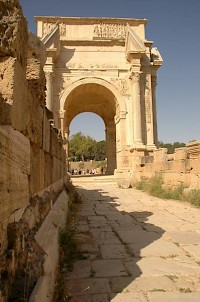
Let's turn to the arch, seen from the city itself. The road is the cardo, which appears to have been lowered a bit to to ensure that the arch really dominated the street. This side of the monument, the northeast face, is decorated with "frieze B". It represents the emperor's pietas, his exemplary religious behavior. This was very important, because as the empire's pontifex maximus (high priest), Septimius Severus was responsible for the pax deorum, "peace with the gods", which ensured that the harvests were plentiful, the rivers kept their course, the earth did not move, and rain fell when it had to. Severus had little patience with dissidents. During his stay in Lepcis Magna in 203, a young Christian named Perpetua was tortured to death in Carthage.
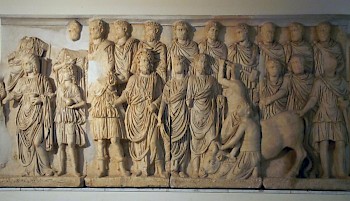
"Frieze B", now in the National Archaeological Museum in Tripoli, shows the imperial family (from left to right, Julia Domna, a long-haired Geta, a damaged and headless representation of the Empire, the emperor himself, Caracalla, and the emperor's brother Geta, attending the sacrifice of a bull, presided by the praetorian prefect, Plautianus.
The reliefs on the piers match frieze B: again, we see the emperor in a religious act, presiding a sacrifice. The representation is split into two registers: the imperial family in the upper register, the sacrifice itself in the lower.
The upper part shows the emperor, presiding the sacrifice. Standing behind him are Hercules, one of the two protective deities of Lepcis, and Caracalla. In the background, you can see a very large temple. The lower register shows an altar and the arrival of two bulls, who are about to be slaughtered.
Southeast: Felicitas
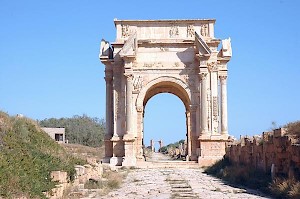
If someone arrived in Lepcis Magna from the southeast, he might have seen the arch like it is shown on the photo to the right. As you can see, to the left and right of the road, the Decumanus, the site has remained unexcavated, and we may hope that one day, missing parts of the Arch of Septimius Severus will be recovered.
This part of the relief, "frieze C", was not of the highest quality (the figures are too long) and is also badly damaged (only four pieces have been recovered so far) but it apparently celebrated the emperor's domestic successes, felicitas. Here we have some mounted senators, knights, or soldiers in civil dress. The bald man in front cannot be a soldier: he is too old.
On the second photo above, Julia Domna can be recognized, together with Mars, one of the founder-deities of Rome. From the empress' presence, we may deduce that elsewhere on this frieze, the emperor himself was represented.
Finally, some other sculpture from the arch of Septimius Severus. To the left, a Victoria from the southeast face. In the center, two reliefs of the twelve Olympian gods. The lower register shows a/o Juno and Jupiter (modeled on Phidias' Zeus at Olympia), but it is not hard to see that Juno and Jupiter are dressed like Julia Domna and Septimius Severus. As always on a Roman triumphal arch, the conqueror is shown as equal to the gods.
